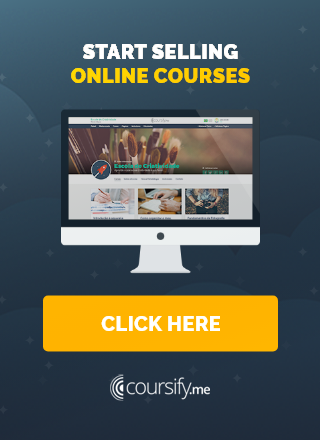Choosing a Topic to Create a Successful Online Course
The key to creating a successful online course is choosing a topic that your audience really wants and needs to learn.
Choosing the topic requires analysis and research, in order to arrive at a coherent result with good sales potential.

Create an Online Course: Step-by-Step to Choosing a Topic
Do you know the difference between a successful and an unsuccessful business?
An unsuccessful business creates a product and then goes out and tries to find someone to buy it. A successful company finds out what people really want and then develops a product to meet that demand.
The same logic can be applied to creating a profitable online course.
But how do you find out what your audience wants? How do you find out what they need so badly they are willing to pay to get it? Check out the step by step below.
Step 1: Do a data analysis
Already have a blog? Social networks where you talk about the subject you want to address? The first step is to take a good look at your engagement and visit data.
Examine the data generated by each publication and try to find some common topics that were most relevant to your audience.
For example, let’s say you have a recipe blog, and a lot of your most popular posts are about making savory sauces.
Analyze this information from the social channels you have, note the perceived trends and move on to Step 2.
– How to use your blog as a marketing tool
Step 2: Listen to your audience
The next step is to listen to what your audience is saying. See comments on your blog, on your social networks and the emails your readers send you.
Are there common threads there? Do you always answer the same questions or are most of the questions your audience asks about the same subject?
Read what they spontaneously write and ask what you want to know. Create a post on social media, a video, send an email if you already have a mailing built, in short, use all the channels at your disposal to find out what your audience needs.
Note that it’s easier to get good answers when you ask them about the difficulties they face than when you ask them exactly what they would like to learn.
Asking about struggles, issues and challenges gets right to the heart of the matter and explores what your audience really needs and would be willing to pay for.
Because ultimately, if you want to create a profitable online course, it needs to solve a big problem, not something that a deeper Google search will answer.
People are willing to pay to have their big difficulties resolved, especially if the course also promises some sort of path to success, like “Learn to code in 5 steps”, or “Miss measures in 15 days”.
There are several ways to ask your audience what they need, but the best ones are usually:
Your email list is where your biggest fans are and where most of your sales are likely to come from, so it makes sense to start by asking your subscribers.
You can write them an email explaining your idea of creating an online course and asking for help in answering a simple question, which may be their biggest challenge with the subject you are used to.
For example: “What is your biggest challenge with sleep?, or “What is your biggest challenge with eating well?‘.
– How to create email campaigns with MailChimp
Social Media Groups
If you have your own Facebook Group related to your field, or participate in one, this is another great place to “interview” your target audience.
To get started, use the questions that group members normally need to answer before they are allowed to join. For example, in the case of a creative writing group, when someone requests access, ask them what their biggest writing challenge is.
Another place you can ask is in your daily conversation starter prompt. Having a daily conversation is a great way to increase engagement in your Facebook group and do market research to create an online course.
If you don’t have your own Facebook group, you can try asking this question in other people’s groups, but make sure you choose one related to your niche.
Market research
Performing this research is important to assess whether there is a market for your course and give you more security before you start.
There are different channels to do this query and three highly recommended are: Google, BuzzSumo and Amazon.
You can create an audience survey using a survey application such as Google Forms.
With this type of tool you can ask your question about challenges related to your niche, as well as ask extra questions and dig deeper.
However, ensure that your survey takes no more than 5 minutes to complete. If it takes much longer than that, your return rate will be low.
– 3 ways to validate your idea before creating online courses
Competition
Searching for competing courses can give you an idea if the topic you intend to cover is in demand and if there are already enough people trying to solve it.
Search Google, Amazon, popular podcasts and other platforms related to online education.
Consult virtual schools that offer courses with themes similar to what you intend to address and take the opportunity to observe how the contents are structured, what prices are charged, how the marketing is done, etc.
Beware, if there is little or no competition, this is a bad sign. It probably means that there is little or no demand for your idea.
IMPORTANT: Don’t be discouraged if you find that your course topic is in low demand or competition. Try to refine your idea to see if there’s a different approach you can take, or another related theme.
Step 3: Be specific
After performing the steps above, you should already be starting to see some repeating topics. But be careful. A common mistake is trying to create an online course that tries to answer all the problems at once.
The most successful courses are usually those that solve a specific problem.
So, for example, if you have a blog about maternity, don’t try to create an online course that solves all the problems related to baby care. Start by solving just one big problem, like “how to get your baby to sleep well” or “how to help your child communicate better while he hasn’t developed language yet.”
So, take a good look at all the ideas you’ve gathered so far and find within them a topic you’ve mastered and would like to teach.
If there is more than one, write them all down to create more courses in the future, but definitely start with one, preferably your favorite topic or the one most requested by your audience.
– 10 profitable niches for online courses
Step 4: Focus on results
The key to creating a successful online course is not so much choosing a topic as making it clear to your audience what RESULTS they will get.
So instead of just thinking about choosing a ‘topic’ for your elearning course, think about defining a ‘transformation’ or an ‘outcome’.
People who want to lose weight do not want to hear a speech about the benefits of healthy eating, they want and need a consistent plan to lose weight.
Anyone who enrolls in a cake decorating course wants to know what techniques they will learn and what results they should get by the end of the course.
So take the time to go through your list of course ideas and reframe them as transformations. Or, in other words, what result will you give the students in your course.
Step 5: Test your idea
You’ve come this far with one, maybe even two or three ideas for creating a successful online course. Now, the next step is to validate your idea, in other words, check if the chosen theme can really be profitable.
The best way to do this is to create free trial content for your course. This could be a webinar where you will talk a little about the topic, a short video lesson, a first module of the course, etc. The important thing is that it is free. Advertise as a freebie to your audience.
If enough people sign up to participate, you know that your paid course will likely be popular. However, if this does not happen, it is likely that the course does not have good sales potential either, so back to the study of the topic.
Another advantage of offering this freebie is that it will act as a lead magnet, attracting exactly the kind of people who are likely to be interested in purchasing your course when it launches.
Just be careful not to make the freebie too much like your paid course! The best thing to do is offer a small part for free, something like an online minicourse.
– Step by step to create an online minicourse
Or, alternatively, offer something free to help your audience see that they need your paid course.
For example, if you are a fitness trainer planning a course on running your first marathon, your freebie can be a training plan that helps your audience run their first 5K.
With this, not only will your audience have a chance to get to know your course and feel more comfortable about buying it, they will also feel indebted to you for having helped beforehand without charging anything in return.
Choose the right hosting platform

Theme defined, tested and proven, it’s time to get your hands dirty and create a complete online course for your audience.
Take the feedback you received after the presentation of the freebie course and develop the best content you can, to get your students ready to come back for the next one.
Furthermore, all you need is a Learning Management System (LMS) where you can host your courses and make it easy for your students to access.
– Whats is a Learning Management System
Complete eLearning platform, Coursify.me has integration with content platforms such as YouTube and Vimeo. In addition, users can upload videos, texts, images, audios and any other material they have hosted on Dropbox or on their own computer.
Attending schools, businesses and professionals in over 60 countries, Coursify.me is a dynamic Learning Management System ready to serve you.
To learn more, visit our website, test the platform and start creating an online course right now.

